- 1Shanghai Institute of Optics and Fine Mechanics, Chinese Academy of Sciences (CAS), Shanghai, China
- 2University of Chinese Academy of Sciences, Beijing, China
- 3School of Physical Science and Technology, ShanghaiTech University, Shanghai, China
Energetic plasma beams can be generated through the interaction between a short-pulse high-intensity laser and solid target. However, obtaining collimated plasma beams with low divergence remains challenging. In this study, we devised a self-collimation scheme driven by a topologically structured Laguerre–Gaussian (LG) laser that irradiates a thin target in three-dimensional particle-in-cell simulations. It was observed that a high-density and narrow plasma beam could be formed by the intrinsic hollow intensity distribution of the LG laser. A magnetic tunnel was generated around the beam and collimated the plasma beam within a radius of hundreds of nanometers. This collimation can be enhanced by increasing the topological charge from l = 1 to l = 3 and then destroyed for a larger l. The collimation method is promising in applications requiring well-collimated energetic plasma beams, such as indirect drive inertial con-finement fusion, laboratory astrophysics, and radiation therapy.
Introduction
With the advent of the multi-petawatt laser era, the laser pulse intensity can exceed 1022 W/cm2 [1, 2]. When such an intense laser irradiates a solid plasma target, a large number of energetic particles are produced. In the laser-plasma interaction, the laser firstly accelerates the electrons, then the resulting space-charge field accelerates the ions. They move together as a neutral plasma beam that can propagate over a longer distance than non-neutral particle beams [3]. These plasma beams can be used for fast ignition (FI) in inertial confinement fusion [4], tumor therapy, radiographic applications, and understanding astrophysical jet phenomena. However, all these applications require the collimation or low beam divergence of the particle beam. In the FI in inertial confinement fusion, this can significantly enhance the coupling efficiency of the beam to the compressed fusion fuel and avoid a rapid decrease in the beam intensity away from the target [5–7].
Many experiments have demonstrated that the particles (electrons and/or ions) beam has low collimation when using ultrashort high-intensity lasers [8–11]. To solve this issue, a series of simulations and experiments have been proposed to obtain an energetic particle beam with low divergence. For example, Alraddadi et al. used foam-filled resistive guide targets to achieve fast electron collimation [12]. Robinson et al. [13] used an azimuthal magnetic field pre-generated by a laser prepulse to confine the electron beam, where radially inward Lorentz forces played significant roles. Kar et al. [14] used a target with a radius of curvature to acquire a focusing ion-plasma beam. Tonican et al. [15] presented a technique for focusing ion-plasma beams using a radial electric field from a hollow microcylinder. However, these methods require rigorous target engineering or multistage acceleration schemes, which may significantly affect the stability and efficiency of most high-intensity laser-solid interactions. Therefore, a robust collimation scheme is important for various applications. In recent years, relativistic Laguerre–Gaussian (LG) lasers, which have a special structure and hollow light intensity distribution [16], have been generated experimentally [17]. A radially inward ponderomotive force can be generated from the hollow-distributed laser intensity and used to collimate the electron beam.
In this paper, we present a collimation mechanism for generating an extremely converging plasma beam. It is driven by an ultra-intense and ultrashort vortex laser with the topological charge l impinging on a solid plasma target. First, a hollow-structured plasma is formed owing to the hollow intensity distribution of the LG laser. The plasma was then concentrated toward the central axis by the radial ponderomotive force and accelerated forward by the longitudinal force. As the plasma propagates, a plasma beam with high density and current arises on the central axis. Meanwhile, the current in the plasma beam generates a strong magnetic tunnel that confines the plasma beam. Such collimation methods driven by vortex lasers can potentially be applied in a wide range of fields, such as indirect drive inertial confinement fusion, ultrafast diagnostics, and radiation therapy.
Numerical simulation and analysis
Simulation parameter
We performed 3D PIC simulations (EPOCH code [18]) to study the interaction between an ultra-intense ultrashort circularly polarized LG laser pulse and a solid plasma target. The wavelength of the laser pulse was λ0 = 0.8 μm. The laser period is TL = λ0/c, where c is the speed of light in vacuum. The CP LG laser can be expressed as follows:
where a0 = eE0/mecω, e is the electron charge, E0 is the laser amplitude, me is the electron mass, ω is the laser frequency,
The size of the simulation box was 80 μm (x) × 16 μm (y) × 16 μm (z), the number of cells was 800 × 320 × 320, and each cell was filled with two macro-electrons and two macro-protons. The mesh size is Δx = 1/10 μm and Δy = Δz = 1/20 μm. The front surface of the target was located at x = 30 μm and the foil thickness was 1 μm. The foil density was n = 30nc, where
Simulation analysis
The proposed self-collimation mechanism can be divided into three main stages: hole-boring, shock acceleration, and transporting stages. In the hole-boring stage [19], the laser arrives at the front surface of the target at t = 30TL and begins to interact with the plasma target. The LG laser first pushed the electrons to the back surface of the target, leaving the heavy protons behind. Subsequently, a charged separation field between the electrons and ions is generated, accelerating the protons in the following progress [20–23]. Figure 1 shows the hollow-structured intensity distribution of an LG laser with l = 1, 2, and 3. This field profile generates a radial ponderomotive force that first pushes the electrons to the center axis. The resulting charge separation field between the electrons and protons then drags the protons together.
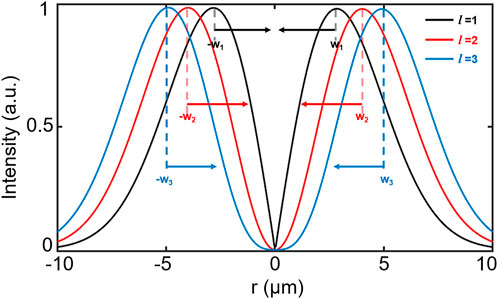
FIGURE 1. Profiles of LG laser intensity with topological l = 1, 2, and 3. The radius w1, w2, and w3 correspond to the maximum light field for the topological charge of l = 1, 2, and 3.
Notably, we used the normalized factor of the LG laser Cpl (Cl=1 = 1.65, Cl=2 = 1.36, Cl=3 = 0.86 for l = 1, 2, 3) in Eq. 1 to maintain the laser intensity for research on the effects of the topological structure factor l on the plasma acceleration and collimation process. These effects are compared in Figure 1, where the maximum laser fields for l = 1, 2, 3 are at w1 = 2.83 μm, w2 = 4 μm, w3 = 4.9 μm, respectively. It is assumed that the radial ponderomotive force of the LG laser plays an important role, which can be expressed as
where -
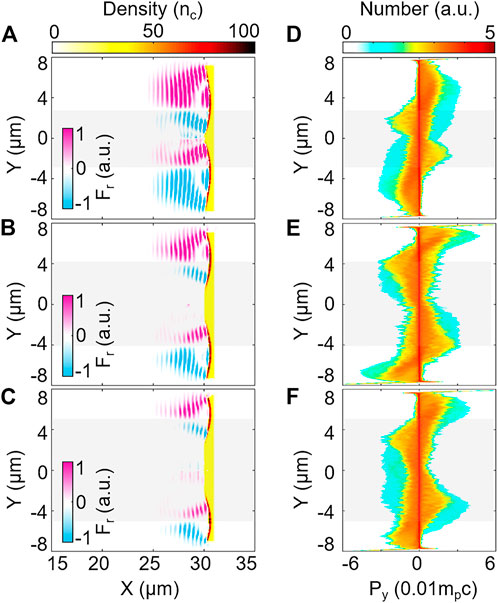
FIGURE 2. Interactions between lasers and plasma targets at t = 50TL. The distribution of the electron density and LG laser ponderomotive force with topological charge (A) l = 1, (B) l = 2, (C) l = 3 are shown. The corresponding proton momentum distribution for the case with (D) l = 1, (E) l = 2, (F) l = 3 are compared. The gray bands represent the focusing regions.
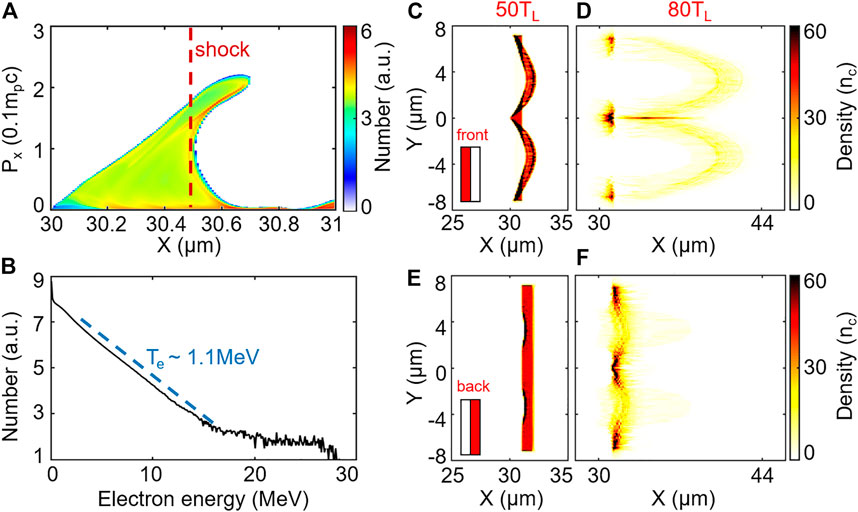
FIGURE 3. Proton acceleration in shock acceleration stage. (A) Proton phase space at t = 50TL. The red dashed line represents the shock front. (B) Electron energy spectrum and electron temperature at t = 50TL. Distribution of (C,D) the protons in the front of the target at t = 50TL, 80TL. Distribution of (E,F) the protons in the back of the target at t = 50TL, 80TL.
To clarify the part of the target that is collimated after the shock acceleration of the target, we divided the target into two parts: the front (30 μm
When the narrow plasma beam appears on the central axis, a negative current is formed, which can be calculated by
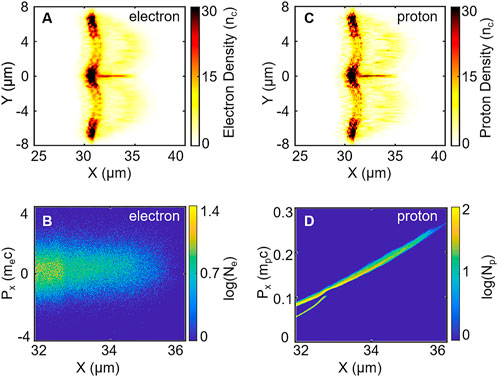
FIGURE 4. Density distribution of (A) the electrons and (B) the protons at t = 80TL. Phase spaces of (C) the electrons and (D) protons in the region (r ≤ 0.2 μm, 32 μm < × < 34 μm).
A narrow plasma beam with current is maintained for several hundred laser cycles in the transporting stage because of the self-generated magnetic field. Here, the magnetic field is assumed to be quasistatic because it is maintained for a long time, as shown in Figure 5 (right column). In the region near the target area (30 μm
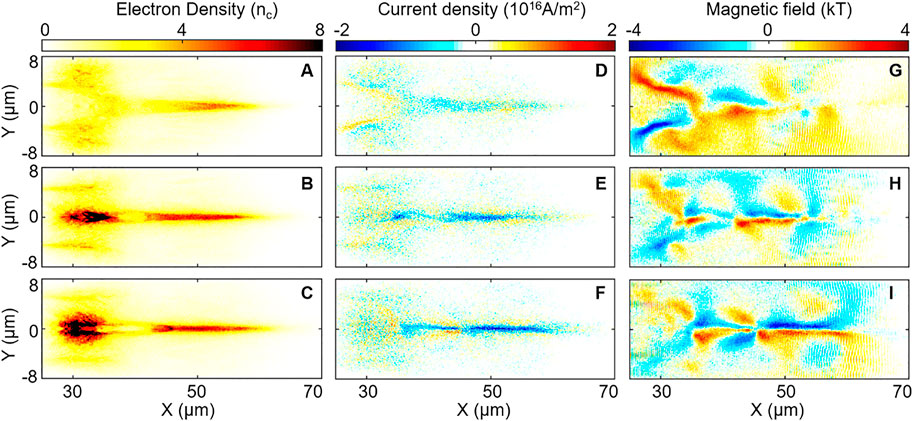
FIGURE 5. Collimation results driven by different topological structured LG lasers. Longitudinal cross sections of electron particle density ne (A–C), current density (D–F), and magnetic field (G–I) at t = 200TL for topological charge of laser l = 1 (top row), l = 2 (center row), and l = 3 (bottom row). For the current, the forward-moving electrons in the plasma beam defined here as a negative current are indicated in blue, whereas the positive current densities corresponding to the return current of the surrounding electrons are indicated in red.
Discussion
In the following section, the magnetic field effects on the collimation mechanism are described. It is well-known that the magnetic field is
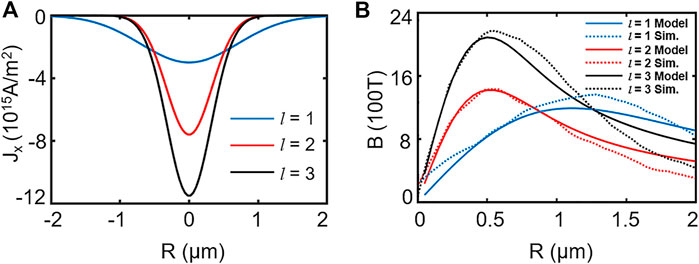
FIGURE 6. (A) Fitted current density distribution for the case of l = 1 (blue), l = 2 (red), and l = 3 (black). (B) The magnetic field in the rigid beam model calculation (solid line) and simulations (dotted line) for the case of l = 1 (blue), l = 2 (red), and l = 3 (black).
The electrons can then be collimated in a quasistatic magnetic field with intensity B and radius Lr. Electrons with divergence
where
The collimation of the plasma beams disappears with an increase in the topological parameter l for the LG laser. For the example of l = 5, the electrons cannot be well collimated in a long-size tunnel t = 160TL as the case in Figure 7, although they are focused onto a spot at x = 45 μm. This is mainly because the intensity is smoothly distributed near the beam axis (r = 0), resulting in a small ponderomotive force at the center and weak concentrating effects on the plasma beam.
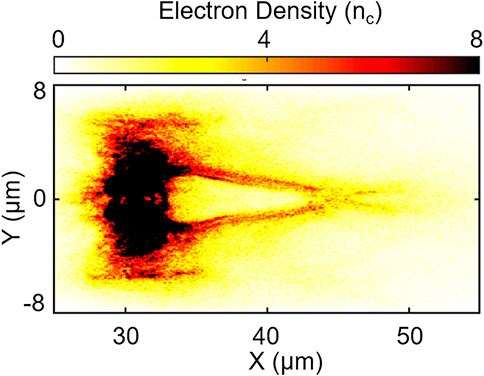
FIGURE 7. Longitudinal cross sections of electron density at t = 160TL for topological charge of laser l = 5.
Conclusion
The self-collimation mechanism of an energetic plasma beam driven by an ultra-intense and ultrashort LG laser was demonstrated by 3D PIC simulation. A narrow plasma beam was formed and collimated to hundreds of nanometers and transported for a long time. On the one hand, the radial ponderomotive force of the LG laser can first concentrate the plasma into the center. On the other hand, such a beam can be further self-collimated by a magnetic field tunnel for a longer time. Studies have shown that better collimation can be achieved by properly choosing the topological charge l of an LG laser. It is important to achieve a better collimation effect and stable magnetic field when l = 3. The proposed scheme provides a simple and effective method for generating a collimated plasma beam and magnetic tunnel, which is useful in many applications, such as fast ignition in inertial confinement fusion, medical therapy, and astrophysics.
Data availability statement
The original contributions presented in the study are included in the article/Supplementary Material, further inquiries can be directed to the corresponding author.
Author contributions
HD conducted the simulations and drafted the manuscript. WW supervised the work. All authors discussed the results and reviewed the manuscript.
Conflict of interest
The authors declare that the research was conducted in the absence of any commercial or financial relationships that could be construed as a potential conflict of interest.
Publisher’s note
All claims expressed in this article are solely those of the authors and do not necessarily represent those of their affiliated organizations, or those of the publisher, the editors and the reviewers. Any product that may be evaluated in this article, or claim that may be made by its manufacturer, is not guaranteed or endorsed by the publisher.
References
1. Tiwari G., Gaul E., Martinez M., Dyer G., Gordon J., Spinks M., et al. Beam distortion effects upon focusing an ultrashort petawatt laser pulse to greater than 1022 W/Cm2. Opt Lett (2019) 44(11):2764. doi:10.1364/ol.44.002764
2. Yoon J. W., Kim Y. G., Choi I. W., Sung J. H., Lee H. W., Lee S. K., et al. Realization of laser intensity over 2023 W/Cm2. Optica (2021) 8(5):630. doi:10.1364/optica.420520
3. Roth M., Cowan T. E., Key M. H., Hatchett S. P., Brown C., Fountain W., et al. Fast ignition by intense laser-accelerated proton beams. Phys Rev Lett (2001) 86(3):436–9. doi:10.1103/PhysRevLett.86.436
4. Xu H., Yu W., Yu M. Y., Cai H. B., Luan S. X., Yang S. H., et al. High energy density micro plasma bunch from multiple laser interaction with thin target. Appl Phys Lett (2014) 104(2):024105. doi:10.1063/1.4858956
5. Ramakrishna B., Kar S., Robinson A. P., Adams D. J., Markey K., Quinn M. N., et al. Laser-driven fast electron collimation in targets with resistivity boundary. Phys Rev Lett (2010) 105(13):135001. doi:10.1103/PhysRevLett.105.135001
6. Badziak J., Parys P., Rosiński M., Zaraś-Szydłowska A. Laser-driven accelerator of intense plasma beams for materials research. Fusion Eng Des (2017) 124:1298–301. doi:10.1016/j.fusengdes.2017.01.061
7. Wang W. Q., Yin Y., Zou D. B., Yu T. P., Xu H., Shao F. Q. Effects of parameters on the proton focusing driven by coulomb explosion. High Energ Density Phys (2019) 32:77–81. doi:10.1016/j.hedp.2019.06.003
8. Zhuo H. B., Chen Z. L., Sheng Z. M., Chen M., Yabuuchi T., Tampo M., et al. Collimation of energetic electrons from a laser-target interaction by a magnetized target back plasma preformed by a long-pulse laser. Phys Rev Lett (2014) 112(21):215003. doi:10.1103/PhysRevLett.112.215003
9. Stephens R. B., Snavely R. A., Aglitskiy Y., Amiranoff F., Andersen C., Batani D., et al. Kαfluorescence measurement of relativistic electron transport in the context of fast ignition. Phys Rev E (2004) 69(6):066414. doi:10.1103/PhysRevE.69.066414
10. Lancaster K. L., Green J. S., Hey D. S., Akli K. U., Davies J. R., Clarke R. J., et al. Measurements of energy transport patterns in solid density laser plasma interactions at intensities of 5×1020 W cm−2. Phys Rev Lett (2007) 98(12):125002. doi:10.1103/PhysRevLett.98.125002
11. Kar S., Markey K., Simpson P. T., Bellei C., Green J. S., Nagel S. R., et al. Dynamic control of laser-produced proton beams. Phys Rev Lett (2008) 100(10):105004. doi:10.1103/PhysRevLett.100.105004
12. Alraddadi R. A. B., Robinson A. P. L., Woolsey N. C. Improved fast electron transport through the use of foam guides. Phys Plasmas (2020) 27(9):092701. doi:10.1063/5.0011723
13. Robinson A. P., Sherlock M., Norreys P. A. Artificial collimation of fast-electron beams with two laser pulses. Phys Rev Lett (2008) 100(2):025002. doi:10.1103/PhysRevLett.100.025002
14. Kar S., Markey K., Borghesi M., Carroll D. C., McKenna P., Neely D., et al. Ballistic focusing of polyenergetic protons driven by petawatt laser pulses. Phys Rev Lett (2011) 106(22):225003. doi:10.1103/PhysRevLett.106.225003
15. Toncian T., Borghesi M., Fuchs J., d'Humieres E., Antici P., Audebert P., et al. Ultrafast laser-driven microlens to focus and energy-select mega-electron volt protons. Science (2006) 312(5772):410–3. doi:10.1126/science.1124412
16. Bacon E. F. J., King M., Wilson R., Frazer T. P., Gray R. J., McKenna P. High order modes of intense second harmonic light produced from a plasma aperture. Matter Radiat Extremes (2022) 7(5):054401. doi:10.1063/5.0097585
17. Wang W. P., Jiang C., Dong H., Lu X. M., Li J. F., Xu R. J., et al. Hollow plasma acceleration driven by a relativistic reflected hollow laser. Phys Rev Lett (2020) 125(3):034801. doi:10.1103/PhysRevLett.125.034801
18. Arber T. D., Bennett K., Brady C. S., Lawrence-Douglas A., Ramsay M. G., Sircombe N. J., et al. Contemporary particle-in-cell approach to laser-plasma modelling. Plasma Phys Control Fusion (2015) 57(11):113001. doi:10.1088/0741-3335/57/11/113001
19. Robinson A. P. L. Production of high energy protons with hole-boring radiation pressure acceleration. Phys Plasmas (2011) 18(5):056701. doi:10.1063/1.3562551
20. Wang W. P., Shen B. F., Zhang X. M., Ji L. L., Yu Y. H., Yi L. Q., et al. Dynamic study of a compressed electron layer during the hole-boring stage in a sharp-front laser interaction region. Phys Rev ST Accel Beams (2012) 15(8):081302. doi:10.1103/physrevstab.15.081302
21. Wang W. P., Shen B. F., Xu Z. Z. Accelerating gradient improvement from hole-boring to light-sail stage using shape-tailored laser front. Phys Plasmas (2017) 24(1):013104. doi:10.1063/1.4973330
22. Wang W. P., Shen B. F., Zhang X. M., Ji L. L., Wen M., Xu J. C., et al. Ultra-intense single attosecond pulse generated from circularly polarized laser interacting with overdense plasma. Phys Plasmas (2011) 18:083104. doi:10.1063/1.3623588
23. Wang W., Jiang C., Li S., Dong H., Shen B., Leng Y., et al. Monoenergetic proton beam accelerated by single reflection mechanism only during hole-boring stage. High Pow Laser Sci Eng (2019) 7(3):e55. doi:10.1017/hpl.2019.40
24. Forslund D. W., Shonk C. R. Formation and structure of electrostatic collisionless shocks. Phys Rev Lett (1970) 25(25):1699–702. doi:10.1103/PhysRevLett.25.1699
25. Snavely R. A., Key M. H., Hatchett S. P., Cowan T. E., Roth M., Phillips T. W., et al. Intense high-energy proton beams from petawatt-laser irradiation of solids. Phys Rev Lett (2000) 85(14):2945–8. doi:10.1103/PhysRevLett.85.2945
26. Borghesi M., MacKinnon A. J., Bell A. R., Gaillard R., Willi O. Megagauss magnetic field generation and plasma jet formation on solid targets irradiated by an ultraintense picosecond laser pulse. Phys Rev Lett (1998) 81(1):112–5. doi:10.1103/PhysRevLett.81.112
27. Stamper J. A., Papadopoulos K., Sudan R. N., Dean S. O., McLean E. A., Dawson J. M. Spontaneous magnetic fields in laser-produced plasmas. Phys Rev Lett (1971) 26(17):1012–5. doi:10.1103/PhysRevLett.26.1012
28. Davies J. R., Green J. S., Norreys P. A. Electron beam hollowing in laser–solid interactions. Plasma Phys Control Fusion (2006) 48(8):1181–99. doi:10.1088/0741-3335/48/8/010
Keywords: Laguerre-Gaussian laser, magnetic field, collimation, plasma beam, particle-in-cell simulation
Citation: Dong H, Wang WP, Lv ZX, Jiang C, He JZ, Leng YX, Li RX and Xu ZZ (2022) Topological structure effects of Laguerre-Gaussian laser on self-collimation acceleration mechanism. Front. Phys. 10:1054778. doi: 10.3389/fphy.2022.1054778
Received: 27 September 2022; Accepted: 05 December 2022;
Published: 15 December 2022.
Edited by:
Guo-Bo Zhang, National University of Defense Technology, ChinaReviewed by:
Hu Lixiang, National University of Defense Technology, ChinaJu-Kui Xue, Northwest Normal University, China
Copyright © 2022 Dong, Wang, Lv, Jiang, He, Leng, Li and Xu. This is an open-access article distributed under the terms of the Creative Commons Attribution License (CC BY). The use, distribution or reproduction in other forums is permitted, provided the original author(s) and the copyright owner(s) are credited and that the original publication in this journal is cited, in accordance with accepted academic practice. No use, distribution or reproduction is permitted which does not comply with these terms.
*Correspondence: W. P. Wang, d2FuZ3dlbnBlbmdAc2lvbS5hYy5jbg==
†These authors have contributed equally to this work
 H. Dong
H. Dong W. P. Wang
W. P. Wang Z. X. Lv1
Z. X. Lv1